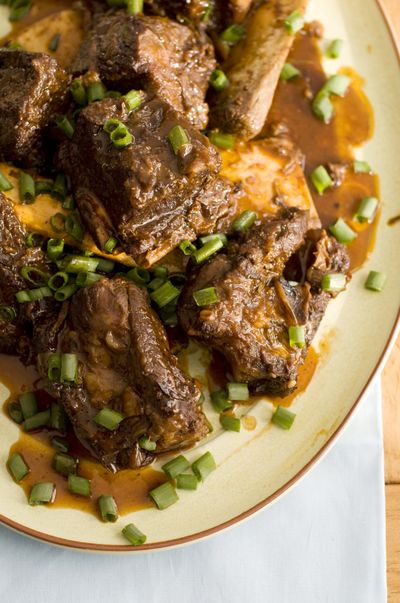Tender goodness
Browning short ribs before braising in balsamic, stock, gives flavor boost

Cool days call for cooking that is low, slow and wet. Which is to say, braised.
And it’s simpler than you might think. Braising is just a matter of cooking food, usually meat, for a long period at a low temperature and submerged in some kind of liquid. Pot roasts are a good example. Many foods cooked in a slow cooker also qualify.
Beef stews are another great example. A long, slow simmer is used to break down and tenderize cuts of meat that otherwise would be tough and unappealing. And this is true for all manner of meats. Goat and lamb, especially the shanks, frequently are braised to produce succulently tender meals.
This is why many braising recipes call for the fattier or tougher cuts of meat. The added benefit is that these also tend to be the cheapest cuts. For example, chicken thighs would be a good choice for braising, while chicken breasts would not. Pork shoulder would be another option, rather than the lean tenderloin.
Of course, braising doesn’t have to be limited to meat. Vegetables also can be braised. Fibrous vegetables (such as fennel or winter greens) and root vegetables (such as parsnips and carrots) take particularly well to braising. The technique is done the same as for meat, though vegetables don’t take as long to braise.
Often in braising you’ll find that the meat or veggies are seared prior to adding the liquid. This deepens the flavor. The browning and caramelizing of the surfaces serves to flavor the liquid and the finished dish. Liquid and seasonings then are added to come half to two-thirds up the side of the food. Then the dish is brought to a low simmer and kept that way.
Braising can be done over a low heat on the stove, or at moderate heat in the oven. Usually the pot remains covered for the majority of the cooking.
Either way, this is a relatively hands-off process. Once the dish is cooking, you just let it do its thing. Sometimes the cover is removed toward the end of cooking so the liquid can reduce some and the food can brown on the top. And sometimes the liquid is reduced further to serve as a glaze or a thickened sauce. Regardless of the chosen consistency, some of the liquid is almost always served with the food.
For our braising recipe, we opted for short ribs. Short ribs are the perfect cut of meat to be braised. They have quite a bit of marbling and can be tough if not properly cooked. You can get short ribs off the bone, but for the best flavor, opt for on-the-bone.
We’re braising in a tangy blend of balsamic vinegar and seasoned stock. A lot of the flavor comes from the caramelizing of the meat and the vegetables, so don’t skimp on the browning. After the meat is tender, we boil the liquid down to a glaze. Serve the short ribs and their glaze over mashed potatoes, creamy polenta or egg noodles.
Balsamic Braised Short Ribs
1 tablespoon vegetable or canola oil
6 bone-in short ribs (about 3 pounds)
2 leeks, white parts only, sliced
2 medium yellow onions, sliced
2 carrots, peeled and cut into 1-inch pieces
2 stalks celery, cut into 1-inch pieces
2 cloves garlic, chopped
1/2 teaspoon red pepper flakes
1 teaspoon salt
1/2 teaspoon ground black pepper
2 tablespoons tomato paste
1 tablespoon Dijon mustard
3 sprigs fresh rosemary
1/2 cup balsamic vinegar
1/4 cup packed brown sugar
1 quart unsalted beef stock
In a large, heavy-bottomed pot such as a Dutch oven, heat the oil over medium. Working in batches so as not to crowd the pan, sear the short ribs for 3 to 4 minutes on each side, or until well browned. Transfer the short ribs to a plate.
Add the leeks, onions, carrots, celery and garlic to the pot and cook until well browned, stirring occasionally, about 12 to 15 minutes. Add the red pepper flakes, salt, pepper and tomato paste, then cook until the tomato paste turns a brick reddish-brown color, about 6 to 7 minutes.
Add the Dijon mustard, rosemary sprigs, balsamic vinegar and brown sugar. Scrape up any browned bits from the bottom of the pot. Return the short ribs to the pot, then add the beef stock. Bring the mixture up to a low simmer and cover.
The pot can be left on the stovetop on low heat or placed in a 325-degree oven for 1 1/2 to 2 hours, or until the short ribs are very tender when pierced with a fork.
Carefully transfer the meat to a platter. Cover with foil and a couple of kitchen towels to keep warm. Using a slotted spoon, remove and discard the solids from the liquid. Bring the liquid to a boil on the stovetop and cook until reduced to 1 cup. Drizzle the glaze over the short ribs and serve.
Yield: 6 servings
Approximate nutrition per serving: 550 calories, 26 grams fat (10 grams saturated, 44 percent fat calories), 48 grams protein, 29 grams carbohydrate, 135 milligrams cholesterol, 3 grams dietary fiber, 650 milligrams sodium.